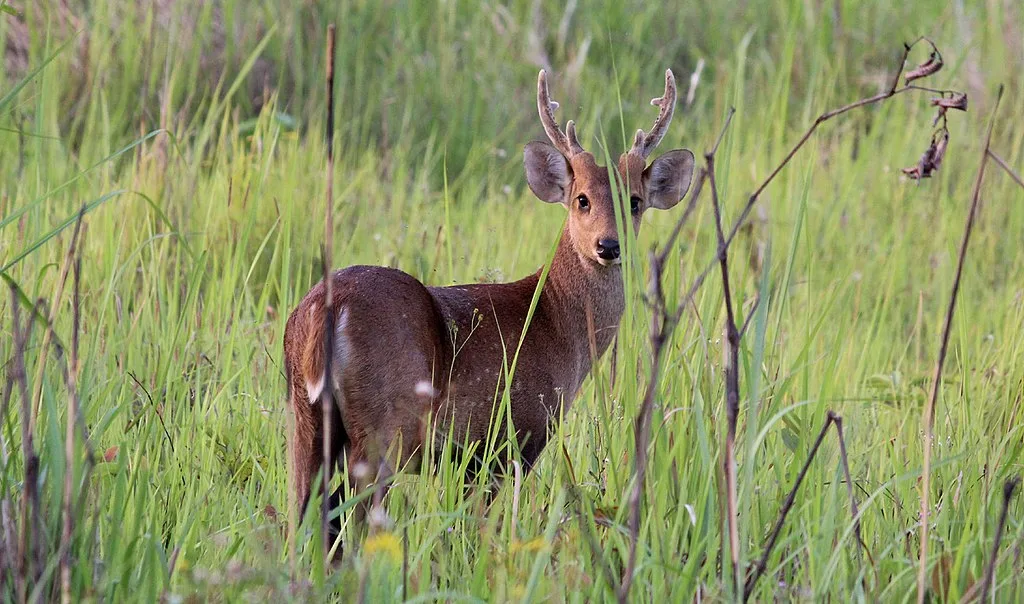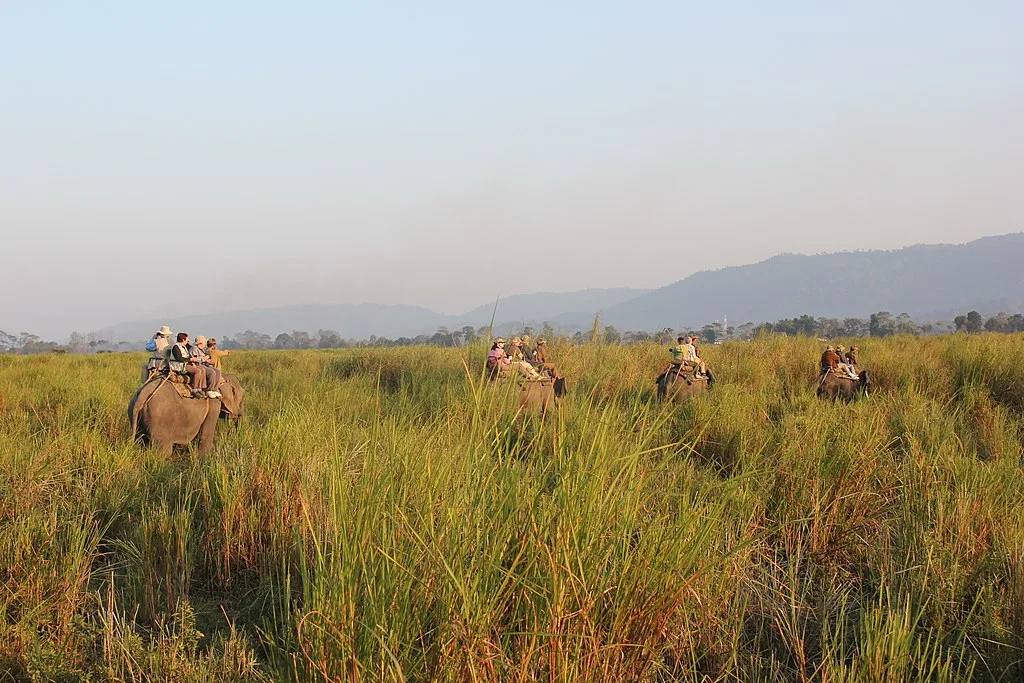Welcome to the enchanting world of Manas National Park – a treasure trove of biodiversity nestled in the heart of Assam, India. Spread over a sprawling landscape of lush greenery and vibrant wildlife, this park is a testament to the beauty and importance of nature conservation. Let’s embark on a journey through its history, diverse flora and fauna, thrilling safari experiences, travel tips, and more.
What is Manas National Park famous for?
Manas National Park has gained widespread fame for several remarkable reasons. Firstly, its rich and storied history, which dates back to its origins as a royal hunting ground, adds a unique layer of significance. This history has transformed it from a hunting haven to a conservation stronghold, earning it UNESCO World Heritage Site status in 1985.
The park’s fame also rests on its remarkable biodiversity. It is home to a staggering variety of flora and fauna, making it a hotspot for wildlife enthusiasts and researchers alike. Among its celebrated inhabitants are the endangered Bengal tigers and one-horned Indian rhinoceroses, both iconic species that contribute to the park’s allure. The park’s successful conservation efforts, such as the revival of the pygmy hog from the brink of extinction, are inspiring tales that have garnered global attention.
Moreover, Manas National Park’s safari experiences are nothing short of enthralling. Embarking on a safari here provides an intimate encounter with the park’s wildlife, with chances to spot majestic creatures in their natural habitat. Jeep and elephant safaris offer distinct perspectives, enhancing the thrill of the adventure.
The park’s cross-border collaboration with the Royal Manas National Park in Bhutan adds an international dimension to its fame. This partnership underscores the importance of transboundary conservation efforts and highlights the park’s global significance.
In essence, Manas National Park’s fame is a fusion of its historical legacy, remarkable biodiversity, conservation successes, and immersive safari experiences. It stands as a testament to the harmonious coexistence of nature and humanity, a sanctuary where the past, present, and future intertwine in a tapestry of natural wonder.
History of Manas National Park: From Royal Playground to Conservation Haven
The history of Manas National Park is a tale of transformation that spans centuries. Once a favored hunting ground for British colonial officials and Indian royalty, the park’s journey has evolved into a beacon of conservation.
Dating back to the early 20th century, Manas served as a royal hunting ground, cherished by those seeking the thrill of the hunt. Its name, derived from the Goddess Manasa, infuses mythological significance into the region, adding an ethereal layer to its history.
In 1928, the park underwent a pivotal shift as it was declared a wildlife sanctuary, marking the beginning of its formal conservation journey. This designation marked the first steps towards protecting the diverse flora and fauna that called the park home.
The recognition continued to grow, culminating in its UNESCO World Heritage Site status in 1985. This distinction was a testament to the tireless efforts of conservationists who recognized the park’s ecological significance and worked diligently to preserve its delicate balance.
Today, the history of Manas National Park echoes the commitment of individuals and organizations dedicated to preserving its natural heritage. It serves as a living example of how a place once reserved for hunting can metamorphose into a sanctuary that nurtures and safeguards the very creatures that once were pursued. The park’s history stands as a reminder that conservation is not just a modern endeavor; it’s a continuum of efforts spanning generations, united in their dedication to the wild.
Flora at Manas National Park: A Lush Mosaic of Life

At Manas National Park, nature unfurls its vibrant palette through an array of flora that captivates the senses. The park’s landscape showcases a rich tapestry of diverse vegetation, from towering trees to delicate blossoms. The dense tropical evergreen forests provide sanctuary to an incredible variety of plant species, each playing a vital role in the park’s ecosystem.
The sight of majestic sal trees dominating the canopy is a common sight, offering shade and sustenance to the park’s inhabitants. Beneath them, a multitude of undergrowth thrives, from hardy shrubs to intricate ferns. Orchids, celebrated for their exotic beauty, grace the landscape with their presence, each delicate petal a testament to nature’s artistry.
As the sun filters through the leaves, casting dappled shadows, and the air carries the scent of wildflowers, visitors are reminded that at Manas National Park, nature’s canvas is alive and ever-evolving. The flora is not merely an observer; it’s an integral player in the intricate dance of life that unfolds within this sanctuary of biodiversity.
Fauna at Manas National Park: A Symphony of Wildlife

Manas National Park comes alive with a vibrant cast of fauna that roams freely in its natural habitat. This sanctuary boasts an impressive array of animal and bird species, making it a paradise for wildlife enthusiasts.
The park takes pride in harboring the endangered Bengal tiger, whose majestic presence commands reverence. The iconic one-horned Indian rhinoceros, a symbol of strength, also find refuge here. The wilderness echoes with the trumpeting of wild elephants, their familial bonds evident as they navigate the landscape.
The clouded leopard, a master of stealth, adds an air of mystery to the park’s ambiance. The tiny pygmy hog, once on the brink of extinction, finds a second chance within the park’s protective embrace.
One must not overlook the endangered Golden Langur’s haven in the park. These enchanting creatures find solace amidst the foliage, their golden fur harmonizing with the verdant backdrop.
For avian aficionados, Manas offers a symphony of bird species, with approximately 450 different types gracing the skies. From vibrant kingfishers to majestic hornbills, the air is alive with their calls and colors.
As the sun rises over the grasslands and the dew-kissed leaves rustle, one can’t help but feel a profound connection to the intricate web of life that thrives at Manas National Park. Each creature, each bird, contributes to the enchanting tale of survival and coexistence, reminding us of the delicate balance that sustains this wondrous ecosystem.
Safari Experience at Manas National Park: Thrilling Encounters with Nature

Embarking on a safari at Manas National Park is an exhilarating journey into the heart of the wild. The park offers a captivating safari experience that immerses visitors in the natural rhythms of its inhabitants.
Guided by seasoned experts, safari-goers have the opportunity to witness the grandeur of the Bengal tiger as it prowls through its domain. The sight of a herd of elephants leisurely strolling by is a scene straight out of a wildlife documentary, both awe-inspiring and humbling.
Jeep safaris allow for an up-close encounter with the park’s denizens, offering unobstructed views of their behavior and interactions. For a unique perspective, the elephant safaris provide an intimate vantage point from the back of these gentle giants. Imagine the thrill of being in the presence of a rhinoceros or a deer, all while riding atop an elephant.
As the day dawns, the air is filled with anticipation, and as the sun sets, the memories of the day’s encounters linger. The safari experience at Manas National Park is not just a glimpse into the wild; it’s a sensory immersion into the untamed beauty of nature, an experience that leaves an indelible mark on the soul.
Journeying to Manas National Park
Reaching Manas National Park is an adventure in itself. The nearest airport, Lokpriya Gopinath Bordoloi International Airport in Guwahati, is well-connected to major cities across India. From the airport, a scenic drive of approximately 4-5 hours will take you to the park’s entrance. For those traveling by train, Barpeta Road Railway Station is the closest, followed by a road journey to the park.
The road leading to the park is a treat for nature enthusiasts. It winds through picturesque landscapes, passing by tea gardens, traditional villages, and rolling hills. The journey to the park is not just a means to an end; it’s an integral part of the experience, offering glimpses of Assam’s natural and cultural beauty.
Resting Amidst Nature at Manas National Park
As you plan your visit, it’s important to consider your accommodation options. The park offers a range of choices, from comfortable resorts to eco-friendly lodges that blend seamlessly with the surroundings. Staying within or near the park allows you to fully immerse yourself in the tranquility and beauty of the area.
One such option is the Bansbari Lodge, which offers a luxurious stay in the heart of the park. The lodge combines modern amenities with a rustic ambiance, creating a harmonious blend of comfort and nature. Imagine waking up to the sounds of chirping birds and the rustling of leaves as you prepare for another day of exploration.
Timing Matters for Manas National Park
The best time to visit Manas National Park is during the dry season, which typically spans from November to April. During this period, the weather is pleasant, and the animals are more active, making it easier to spot them. The monsoon season, from May to October, brings heavy rainfall and poses challenges for exploration.
Visiting during the dry season also coincides with the flowering of many plant species, painting the park in vibrant colors. It’s a time when the entire ecosystem comes alive, creating an enchanting atmosphere that’s perfect for both photography and soaking in the natural beauty.
Adventures Beyond Safari at Manas National Park
While safaris are the highlight, there’s much more to do at Manas National Park. Embark on nature walks, where you can learn about the intricate relationships between plants and animals, or take part in birdwatching excursions to spot some of the park’s 450 avian species. Engage in cultural exchanges with local communities to gain a deeper understanding of the area’s heritage.
For a truly immersive experience, consider volunteering with local conservation organizations. This allows you to actively contribute to the park’s preservation while learning from experts in the field. The memories and connections you make during such experiences are bound to stay with you long after you leave.
Unveiling Trivia about Manas National Park
Did you know that Manas National Park is not just a single park, but part of a larger biosphere reserve? It’s interconnected with the Royal Manas National Park in Bhutan, forming a cross-border conservation effort. This collaboration underscores the significance of protecting wildlife and ecosystems beyond national boundaries.
Additionally, the park is a UNESCO Natural World Heritage site due to its exceptional biodiversity and conservation efforts. This prestigious recognition highlights the global importance of the park and its role in safeguarding the delicate balance of nature.
As you can see, Manas National Park is more than just a sanctuary; it’s a living testament to the marvels of nature and the resilience of ecosystems. Whether you’re an avid wildlife enthusiast, a nature lover, or someone seeking a tranquil escape, this park offers an unforgettable experience that will leave you in awe of the wonders of the natural world.
So, pack your bags, embark on an adventure, and immerse yourself in the beauty of Manas National Park. Explore its history, encounter its majestic flora and fauna, and let its tranquility rejuvenate your spirit. It’s time to witness the magic of nature at its finest!
